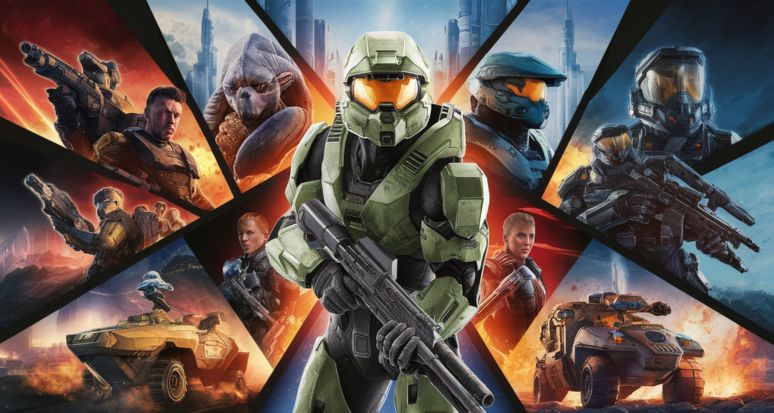Halo (2003), known as Halo: Combat Evolved, is a landmark in the gaming industry. It was first released in 2001 by Bungie and published by Microsoft Game Studios. By 2003, this groundbreaking game had firmly established itself as a cultural phenomenon, inspiring numerous sequels, merchandise, and a dedicated fanbase. This article delves into the game’s iconic status, focusing on the Halo (2003) game icons banners that have become synonymous with the Halo brand.
The Birth of a Legend
When Halo: Combat Evolved was first released, it quickly gained critical acclaim for its compelling storyline, immersive gameplay, and innovative multiplayer features. Set in a futuristic universe where humanity battles the alien Covenant, the game introduced players to the enigmatic Master Chief and his AI companion, Cortana. The success of Halo: Combat Evolved paved the way for a series of sequels and spin-offs, but it also left an indelible mark on the visual culture of gaming through its distinctive game icons and banners.
The Importance of Game Icons and Banners
Game icons and banners play a crucial role in the gaming experience. They are decorative elements and serve as visual identifiers that encapsulate a game’s essence. For Halo (2003), the game icons and banners are more than mere graphics; they are symbols of a gaming legacy that has spanned over two decades.
Iconic Game Icons
The game icons for Halo (2003) are instantly recognizable to fans and gamers alike. The primary icon, featuring the iconic Halo logo, is a simple yet powerful representation of the game. With its sleek, metallic design and futuristic typography, the logo captures the essence of the game’s sci-fi setting.
The Halo Logo: The main icon features the word “Halo” in a stylized, metallic font with a glowing blue ring encircling it. This design reflects the game’s title and the mysterious ringworld that serves as its primary setting.
Master Chief Helmet: Another widely recognized icon is the Master Chief’s helmet. This image, often used in promotional materials and merchandise, symbolizes the protagonist’s stoic and formidable presence.
Cortana: The AI companion Cortana is also a significant icon. Her image, often depicted with holographic elements, represents the technological and narrative depth of the game.
Memorable Banners
Banners for Halo (2003) are equally iconic. These banners often feature dynamic action scenes, key characters, and the distinctive Halo ringworld, creating a sense of epic adventure and high-stakes conflict.
Action-Packed Scenes: Banners depicting intense battle scenes between the Master Chief and the Covenant forces highlight the game’s action-packed gameplay. These images capture the adrenaline-fueled experience that players love.
The Halo Ring: Banners featuring the ringworld itself are visually striking. The Halo ring, with its massive, curving structure set against the backdrop of space, evokes a sense of wonder and mystery.
Character Montages: Banners that include multiple characters, such as Master Chief, Cortana, and various Covenant enemies, provide a comprehensive visual summary of the game’s universe.
Evolution of Icons and Banners
Since its release, Halo (2003) has undergone several updates and remasters, each time bringing changes to its icons and banners. The evolution of these visual elements reflects the game’s enduring popularity and the technological advancements in graphic design.
Original Designs (2001-2003)
The original game icons and banners for Halo (2003) were designed using the technology available. Despite the limitations, these designs effectively conveyed the game’s futuristic and action-oriented themes
Anniversary Editions and Remasters
With the release of Halo: Combat Evolved Anniversary in 2011, the game received updated graphics, including redesigned icons and banners. These new designs retained the original’s core elements while enhancing them with modern visual techniques.
High-Definition Logos: The updated logos featured more detailed textures and lighting effects, making them more visually appealing on high-definition screens.
Enhanced Character Models: Banners with character montages benefited from improved character models, adding more depth and realism to the images.
Dynamic Scenes: The remastered banners included more dynamic and detailed action scenes, showcasing the advancements in graphic design and animation.
Impact on Gaming Culture

The Halo (2003) game icons banners have had a lasting impact on gaming culture. They are not just promotional tools but have become symbols of a beloved franchise. These visual elements have been featured in various forms of media, from game cases and posters to merchandise and fan art.
Merchandise and Collectibles
The popularity of Halo’s icons and banners has led to a wide range of merchandise and collectibles. Fans can purchase posters, t-shirts, and other items featuring these iconic designs. The Master Chief helmet, in particular, has become a popular collectible item.
Fan Art and Community Creations
The Halo community is known for its creativity, and the game’s icons and banners have inspired countless fan art pieces. Artists from around the world have reimagined these designs, contributing to the rich visual culture of the Halo franchise.
Influence on Other Games
The success of Halo (2003) and its visual elements has influenced other games in the industry. The sleek, futuristic designs and epic banners have set a standard for how sci-fi games present themselves visually.
The Legacy Continues
As Halo continues to evolve with new releases and updates, the legacy of its game icons and banners endures. These visual elements remain a vital part of the franchise’s identity, connecting new generations of gamers with the original magic of Halo (2003).
Looking Forward
With the upcoming releases in the Halo series, fans can expect the continued evolution of game icons and banners. While staying true to the original designs, the new iterations will likely incorporate advanced graphics and contemporary artistic trends.
Community Engagement
The Halo community celebrates the game’s legacy through various means, including fan art, cosplay, and online discussions. The Halo (2003) game icons banners remain a focal point in these activities, symbolizing the fanbase’s shared passion and nostalgia.
Technological Advancements
As technology advances, so will the design of game icons and banners. Future iterations of Halo may feature even more detailed and immersive visual elements, further enhancing the gaming experience. Augmented reality (AR) and virtual reality (VR) could bring a new dimension to these iconic designs, allowing players to interact with them in unprecedented ways.
FAQs
1. What is the significance of the game icons in Halo (2003)?
The game icons in Halo (2003) are significant because they encapsulate the essence of the game. They serve as visual identifiers that are instantly recognizable to fans and gamers. These icons, such as the Halo logo and Master Chief’s helmet, symbolize the game’s futuristic and action-packed themes and have become enduring symbols of the franchise.
2. How have the game icons and banners evolved since the original release of Halo: Combat Evolved?
Since the original release of Halo: Combat Evolved, the game icons and banners have undergone several updates and remasters. The original designs were created with the available technology, focusing on simplicity and effectiveness. With the release of Halo: Combat Evolved Anniversary in 2011 and subsequent updates, the icons and banners received high-definition textures, improved lighting effects, and more dynamic and detailed visuals to enhance their appeal on modern screens.
3. What are some of the most iconic game icons from Halo (2003)?
Some of the most iconic game icons from Halo (2003) include:
The Halo Logo: Featuring the word “Halo” in a stylized, metallic font with a glowing blue ring encircling it.
Master Chief’s Helmet: Symbolizing the protagonist’s formidable presence.
Cortana: Depicted with holographic elements, representing the technological and narrative depth of the game.
4. How do the banners for Halo (2003) contribute to the game’s visual identity?
The banners for Halo (2003) contribute to the game’s visual identity by creating a sense of epic adventure and high-stakes conflict. They often feature dynamic action scenes, key characters, and the distinctive Halo ringworld. These banners promote the game and enhance the players’ immersive experience by visually summarizing the game’s universe and themes.
5. Why are the Halo (2003) game icons banners important to gaming culture?
The Halo (2003) game icons banners are essential to gaming culture because they have become symbols of a beloved and influential franchise. They have been featured in various forms of media, from game cases and posters to merchandise and fan art. These visual elements have inspired creativity within the gaming community and have set a standard for how sci-fi games present themselves visually.
Conclusion
The Halo (2003) game icons banners are more than just visual elements; they are a testament to the game’s enduring legacy and impact on the gaming industry. These icons and banners have transcended their original purpose, becoming symbols of a beloved franchise that continues to captivate and inspire gamers worldwide. As the Halo series evolves, the foundational designs from Halo (2003) will remain a cherished part of its history, reminding fans of the game’s groundbreaking beginnings and its lasting influence on gaming culture.
